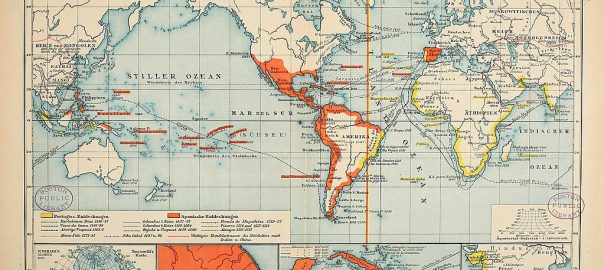By this point, in terms of European projects at world domination and all the plunder, destruction, and genocide that they entailed, Spain was clearly stepping into the number-one role. (See the orange-daubed parts of the world, above. Yellow was Portugal.) The Spanish state was also still actively throwing its weight around inside Europe, whereas the other, more much longer-established European world-imperial power, Portugal, seemed not so interested in doing that. Portugal’s adventurers and merchants were perhaps too busy making useful connections and money in all their many ventures around the African coast and around the rim of the Indian Ocean…
Here’s a listing of the key developments of 1525 CE:
- In February, Spanish forces defeated the French army in Pavia and captured French king Francis I. While he was imprisoned in Madrid, his people made the first overture to Suleiman the Magnificent, to try to build an alliance with the other state leader, in addition to the Spanish monarch, who wielded significant power within Europe. In December, the first French ambassador to the Ottoman “Sublime Porte” would set out for Constantinople.
- In June, Martin Luther got married to an ex-nun. Meantime, the radical ideas he’d been stirring up were badly roiling many parts of the complex archipelago of cities, states, and jurisdictions lying in today’s Germany, Austria, and Switzerland– then, part of the Holy Roman Empire.
- In June, a multi-month conflict called the German Peasants’ War ended with the defeat of the peasants; “over 75,000 peasants” had been killed in the war.
- During 1525, the last Aztec Emperor, Cuauhtémoc, was killed by Spanish conquistador Hernán Cortés. Other conquistadores established the first Spanish-colonial city in Colombia, Santa Marta. Yet other conquistadores, in present-day Guatemala, captured the the city of Mixco Viejo which had been the capital of the Pocomam Maya State. And European-brought diseases swept through the Andes, killing thousands of Indigenes.
- Spain’s King Charles V also sent an expedition to colonize the Moluccas Islands (in present-day Indonesia), claiming they were in his zone of conquest under the Treaty of Tordesillas, since it set no limit to the east. The Spanish expedition docked near to where there was already an established Portuguese outpost. Years of skirmishes followed between the two (to be resolved in 1529.)
- Ming dynasty officials in China ordered ships having more than one mast sailing along the southeast coast to be seized, investigated, and destroyed, in an effort to curb piracy and limit private commercial trade abroad. The Ming also, in April 1525, defeated rebels who’d taken over the northwestern city of Datong.
